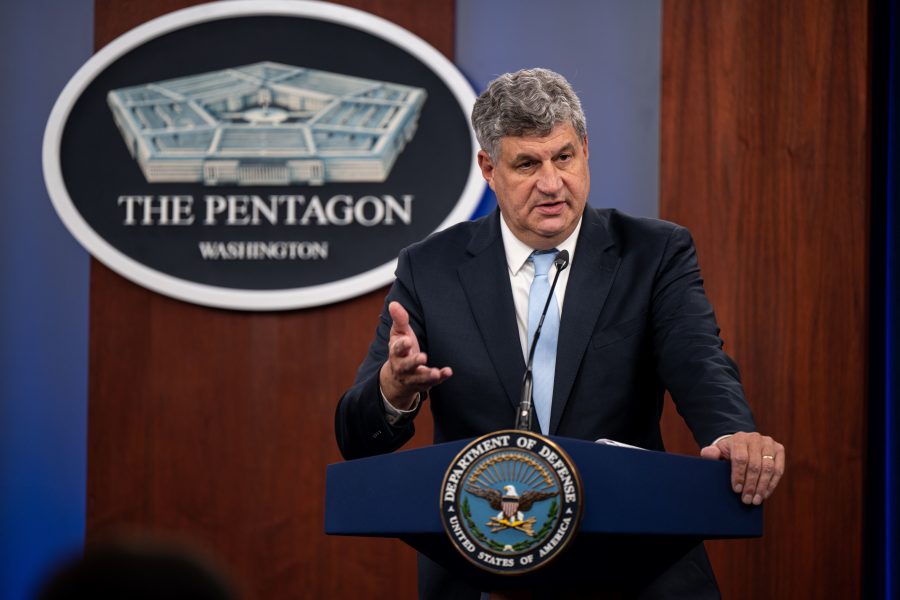The Chinese defense industrial base seems to be doing better than that of the U.S. because it has a streamlined path from development to fielding of new weapons, it places more “bets” on competitive technologies, and it doesn’t have a large legacy inventory with which it has to work, Pentagon acquisition and sustainment chief William LaPlante said Sept. 26.
Speaking at an event with the Center for Strategic and International Studies, LaPlante said, based on his observations of open-source information, that China has an enviable cycle time—‘how long it takes for them to go from … deciding they want to develop something to when it’s fielded, and fielded in numbers.”
In both developing and fielding new high-end capabilities, the Chinese defense industrial base is “really impressive,” LaPlante added.
Moreover, it’s “not just one thing. They place multiple bets. We don’t do that. We very rarely will place multiple bets. In other words, having three different development activities going on. We used to do that. We don’t [anymore,]” he said.
The reason the Pentagon doesn’t typically pursue multiple approaches to solving its operational problems is the cost, he added.
“Our budgets are where they are” he said. “We don’t have the luxury of doing that anymore.”
The multi-pronged approach to development creates an advantage because one concept may be good enough to survive the process, he said, and that creates an opportunity to go into production with a slightly different system as well. That, LaPlante has said previously, complicates an adversary’s decision-making and imposes cost by requiring them to counter a variety of effects and not just one.
Once China’s industry has developed a system, “a winner or the winners go into production, and they field at a high degree of numbers. That’s … what it appears like from the outside,” LaPlante said.
There’s a tendency to paint the Chinese as “10 feet tall,” said LaPlante, but the U.S. should not “project our ways of doing [things] on them.” Still, “it does seem” that China enjoys an advantage from their approach.
Part of China’s speed may also stem from the fact that “they were starting with more of a blank sheet. If you have a large number of legacy platforms” as the U.S. military does, “you can’t do everything at once,” he noted.
Air Force Secretary Frank Kendall has cited this disparity in speed and numbers in production as one of the reasons the service is attempting to keep competition in development programs like the Collaborative Combat Aircraft program, certain munitions, and other efforts, as long as possible.
LaPlante said the key to CCAs and the Pentagon’s nascent “Replicator” programs is not that they are a huge leap in technology, but that they’ll be built in quantities of thousands.
During his 17-month tenure as the acquisition and sustainment czar at the Pentagon, LaPlante has made a mantra of “producing in numbers,” saying that hot weapon production lines are a deterrent while high-end technology still in the laboratory is nearly irrelevant in that context.
“What I’ve been emphasizing the last year and a half is that what matters really … is production. Because if you don’t get these things into production, you don’t field them at scale. You don’t have the supply chain,” LaPlante said. “So right now, we’re at the minimum production that … we can do, and maybe in some ways below it.”
The U.S. does plenty of science and technology, through the Defense Advanced Research Projects Agency and Defense Innovation Unit, among others, he said. But in the pursuit of prototypes, “we minimized actual hard-core development.”
As an example, he noted that the B-21 bomber as one of only a “very few” programs actually in development right now.
That decline in development over the past several decades is due in part to the contraction of the supplier base—with just a few companies left now capable of building fighters, or airlifters, or aerial tankers or vertical lift. Such an outcome “was not an accident,” LaPlante noted.
In 1993, then-Pentagon acquisition czar William Perry gathered defense industry leaders together to urge them to consolidate since the Cold War had just ended and there wasn’t going to be enough business for all military vendors to remain viable—a historic moment now referred to by industry officials as the ‘last supper.’
Indeed, since the end of the Cold War, the defense share of Gross Domestic Product has shrunk, LaPlante noted.
In 1987, “the defense budget was roughly 6-7 percent of GDP,” LaPlante noted. “That would be twice the defense budget we have today. We’d have to have roughly a $2 trillion defense budget today to have what we had in 1987.”
